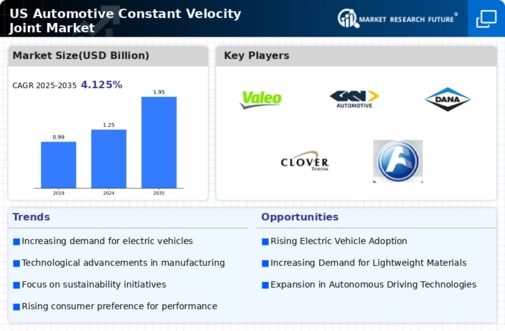Increased Vehicle Production and Sales
The automotive constant-velocity-joint market is significantly influenced by the overall production and sales of vehicles in the United States. Recent data indicates that vehicle sales in the US have shown a steady increase, with a projected growth rate of around 3% annually. This rise in vehicle production directly correlates with the demand for automotive components, including constant-velocity joints. As manufacturers ramp up production to meet consumer demand, the need for high-quality joints becomes paramount. This trend suggests that the automotive constant-velocity-joint market will likely see a corresponding increase in demand, as more vehicles on the road necessitate the use of these critical components for efficient power transfer and enhanced driving experience.
Regulatory Compliance and Emission Standards
The automotive constant-velocity-joint market is also influenced by stringent regulatory compliance and emission standards imposed by government authorities. As regulations become more rigorous, manufacturers are compelled to develop components that not only meet safety requirements but also contribute to reduced emissions. This has led to an increased focus on producing lightweight and efficient constant-velocity joints that enhance vehicle performance while adhering to environmental standards. The automotive industry is projected to invest heavily in research and development to meet these regulations, which could lead to innovations in joint design and materials. Consequently, the automotive constant-velocity-joint market is likely to experience growth as manufacturers strive to comply with evolving standards and consumer expectations.
Growing Popularity of All-Wheel Drive Vehicles
The automotive constant-velocity-joint market is witnessing a growing trend towards all-wheel drive (AWD) vehicles, which require specialized constant-velocity joints to ensure optimal performance. The increasing consumer preference for AWD vehicles, particularly in regions with challenging weather conditions, is driving demand for these components. Market analysis suggests that the AWD vehicle segment is expected to grow by approximately 5% annually, further propelling the need for high-quality constant-velocity joints. This trend indicates that manufacturers in the automotive constant-velocity-joint market must adapt to the rising demand for AWD systems, as they play a critical role in delivering enhanced traction and stability in various driving conditions.
Technological Advancements in Joint Manufacturing
Technological advancements in the manufacturing processes of automotive components are playing a crucial role in shaping the automotive constant-velocity-joint market. Innovations such as precision engineering and the use of advanced materials are enhancing the performance and durability of constant-velocity joints. For instance, the adoption of lightweight materials is not only improving fuel efficiency but also reducing wear and tear on joints. This shift towards more sophisticated manufacturing techniques is expected to drive market growth, as manufacturers seek to produce joints that meet the evolving demands of modern vehicles. The automotive constant-velocity-joint market is likely to benefit from these advancements, as they enable the production of higher-quality components that can withstand the rigors of contemporary driving conditions.
Rising Demand for Advanced Driver Assistance Systems
The automotive constant-velocity-joint market is experiencing a notable surge in demand due to the increasing integration of advanced driver assistance systems (ADAS) in vehicles. As safety regulations become more stringent, manufacturers are compelled to incorporate technologies that enhance vehicle safety and performance. This trend is reflected in the automotive sector, where the market for ADAS is projected to grow at a CAGR of approximately 20% over the next five years. Consequently, the automotive constant-velocity-joint market is likely to benefit from this growth, as these systems often require high-performance joints to ensure optimal functionality. The emphasis on safety and performance in vehicle design is expected to drive the demand for advanced constant-velocity joints, thereby positively impacting the overall market landscape.
















Leave a Comment